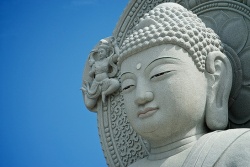Lakkhaṇa
lakkhaṇa: 'characteristics'. For the 3 ch. of existence, s. ti-lakkhaṇa.
lakkhaṇa : [nt.] a sign; mark; characteristic; a prognosticative mark; a quality.
Lakkhaṇa (nt.) [Vedic lakṣman nt. sign; adj. lakṣmaṇa; later Sk. lakṣmaṇa nt. In the defn of grammarians syn. with anka brand, e. g. Dhtp 536 "anka lakkhaṇe lakkha dassane," or Dhtm 748 "lakkha=dassanaanke"; cp. J i.451 lakkhaṇena anketi to brand. <-> The Sk. Np. Lakṣmaṇa appears also in Prk. as Lakkhaṇa: Pischel, Prk. Gr. § 312] 1. sign, characteristic, mark; esp. a sign as implying something extraordinary or pointing to the future, therefore a prognosticative mark (cp. talisman), a distinguishing mark or salient feature, property, quality (as Rh. D. in Dial. i.19 somewhat lengthily, after Bdhgh, trslslakkhaṇa by "signs of good & bad qualities in the foll. things and of the marks in them denoting the health or luck of their owners") D i.9 (a long list, as forbidden practice of fortune -- telling, like maṇi˚ from jewels, daṇḍa˚ from
sticks, asi˚ from marks on swords etc.); Sn 360 (pl. lakkhanā, here as fortune -- telling together with supina telling fr. dreams, cp. SnA 362: daṇḍa˚, vattha˚ etc. referring to D i.9), 927 (with Āthabbana, supina & nakkhatta, all kinds of secret sciences; expld at SnA 564 as "maṇi -- lakkhaṇâdi") 1018 (gottaŋ brūhi sa˚ "with its distinguishing marks"); J vi.364 (sign of beauty); Miln 171 (yathāva˚ just characterization); Mhvs 35, 109 (itthi˚ auspicious signs in women); PvA 161, 219; SnA 386. A long enumn of all sorts of (perfect) marks (tatha -- lakkhaṇāni) is found at DA i.62 sq. Cp. tādi -- lakkhaṇa marks of such (a being), with ref. to good luck etc. J iii.98; SnA 200; VvA 95. -- 2. mark on the body, esp. when serving a def. purpose, e. g. as the branding (of slaves), or the marks of a fortunate being, pointing towards his future greatness: (a) brand J i.451, cp. cpd. ˚āhata. -- (b) the (32) marks of a mahā -- purisa or a great being, either destined to be a rājā cakkavatti, or a sammā -- sambuddha. These are given at Sn 1019 (pl. lakkhanā), 1021, 1022 as only 3 (viz. mukhaŋ jivhāya chādeti, uṇṇ' assa bhamuk' antare, kos' ohitaŋ vattha -- guyhaŋ with ref. to his tongue, the hair between the eyebrows & the sexual organ); more completely as 32 at D ii.16 sq.; iii.142 sq. (the Lakkhaṇa Suttanta); referred to at D i.88, 105; J i.56; Mhvs 5, 91; cp. paripuṇṇa -- kāya Sn 548 (with expln lakkhaṇehi puṇṇatāya at SnA 452). -- 3. (in spec. sense:) pudendum J v.197 (subha˚, the male member), 366. -- 4. (adj.) ( -- ˚) having the marks (of), characterized by, of such & such character A i.102 (kamma˚; bāla˚ & paṇḍita˚, together with bāla -- & paṇḍitanimitta); Miln 111 (sata -- puñña˚, of the Buddha); VvA 71 (para -- sampatti -- usuyyā -- lakkhaṇā issā); PvA 17, 120. -- 5. (as t. t. in philosophy) specific attribute, characteristic (mark). In contrast to nimitta more a substantial attribute or primary characteristic (cp. VbhA 261). Compared with other terms of definition we get the foll.: rasa essential property, paccupaṭṭhāna recurring phenomenon, padatṭhāna immediate occasion DhsA 63 (trsln Expos. i.84), cp. Cpd. 13 (where padaṭṭhāna is trsld as "proximate cause"). -- Ps i.54 sq. (khandhānaŋ); ii.108 (saccānaŋ), VbhA 85, 136 (with ref. to the Paṭiccasamuppāda, cp. Vism 528), 261 (fourfold, of kesā etc.); Vism 278 (with ref. to kammaṭṭhāna) 351 (4, of the dhātus: thaddha˚, ābandhana˚, paripācana˚, vitthambhana˚), 363 sq. (id.), 495 (ariya -- saccānaŋ); VvA 38 (compd with ārammaṇa with ref. to jhāna). -- The 3 properties (tilakkhaṇaŋ) of existing things or of the phenomenal world are anicca, dukkha, anatta, or impermanence, suffering, unreality: thus at J i.48 (dhamma -- desanā ti -- l -- ˚muttā), 275; iii.377 (through contemplating them arises vipassanā & pacceka -- bodhi -- ñāṇa). -- abl. lakkhaṇato "by or qua characteristic," "in its essential qualification," often found in exegetical analysis in Commentary style combd with var. similar terms (atthato, kamato, nimittato etc.), e. g. Vism 351, 363, 495, 528; VbhA 46, 76, 83, 131, 261 (where Vism 351 has paripācana for uṇhatta); SnA 343. -- Cp. upa˚, vi˚, sa˚. -- āhata affected with a mark (of punishment or disgrace), branded Vin i.76; VvA 66. -- kusala clever at interpreting bodily marks or at fortune -- telling from signs (cp. nemittaka) M i.220; J i.272. -- kusalatā cleverness at (telling people's fortune by) signs VvA 138. -- paṭiggāhaka one who reads the signs, a soothsayer, wise man J i.56. -- pāṭhaka an expert in (interpreting) signs, fortune -- teller J i.455; ii.194; v.211. -- manta the secret science of (bodily) marks Sn 690 (but expld at SnA 488 as "lakkhaṇāni ca vedā ca," thus taking it as Dvandva); DhA iii.194. -- sampatti excellency of marks J i.54. -- sampannaendowed with (auspicious) signs Sn 409; J i.455.
the 3 lakkhaṇas at Sn 1022 refer to the brahmin Bāvari. </poem>

